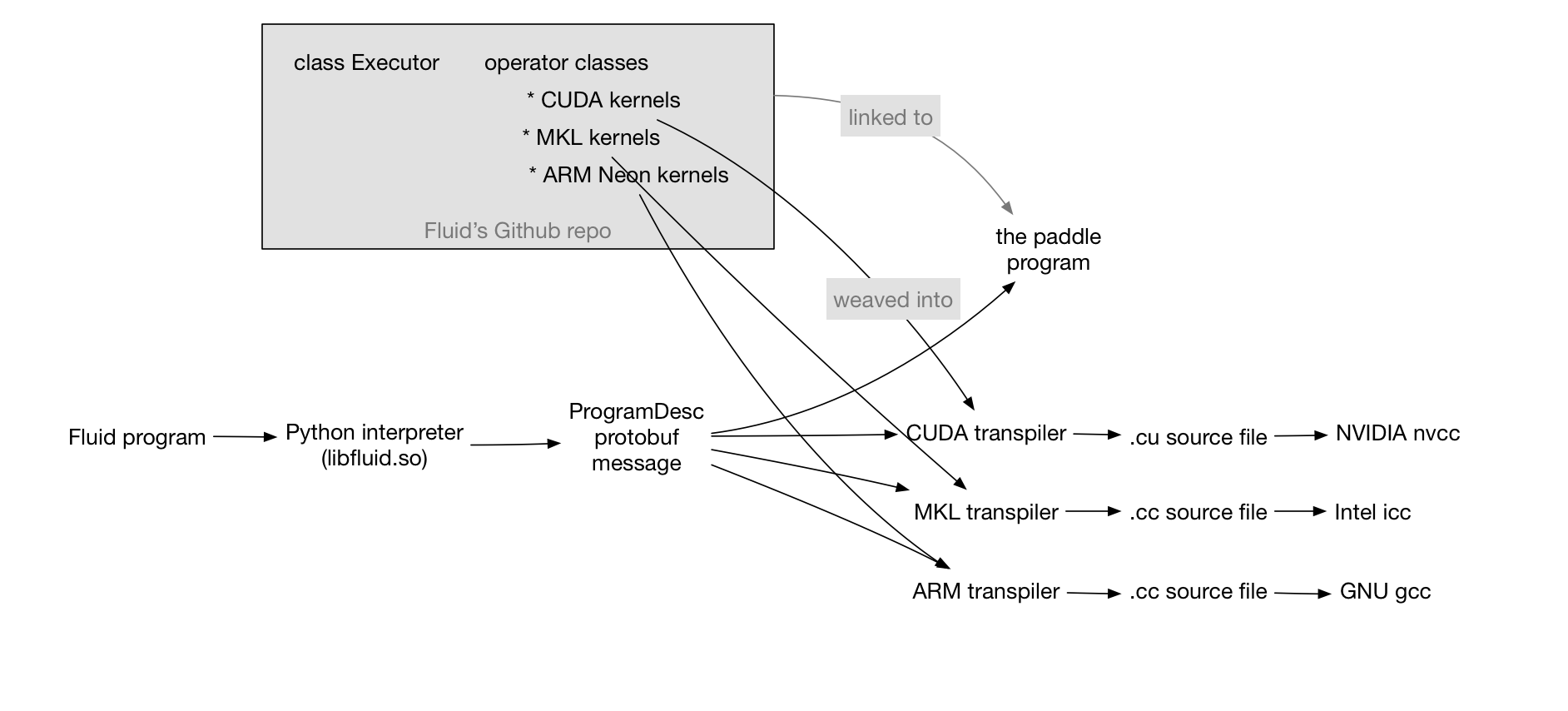PaddlePaddle Fluid: Towards a Compiled Programming Language¶
As described in fluid.md, when a Fluid application program
runs, it generates a ProgramDesc protobuf message as an intermediate
representation of itself. The C++ class Executor can run this
protobuf message as an interpreter. This article describes the Fluid
compiler.

ProgramDesc¶
Before we go deeper into the idea of compiled language, let us take a look at a simple example Fluid application.
import "fluid"
func paddlepaddle() {
X = fluid.read(...)
W = fluid.Tensor(...)
Y = fluid.mult(X, W)
}
This program consists of a block of three operators –
read, assign, and mult. Its ProgramDesc message looks like
the following
message ProgramDesc {
block[0] = Block {
vars = [X, W, Y],
ops = [
read(output = X)
assign(input = ..., output = W)
mult(input = {X, W}, output = Y)
],
}
}
Transpilers¶
We can write a transpiler program that takes a ProgramDesc, e.g.,
the above one, and outputs another ProgramDesc. Let us take some
examples:
- Memory optimization transpiler: We can write a transpiler that
inserts some
FreeMemoryOps in the above exampleProgramDescso to free memory early, before the end of an iteration, so to keep a small memory footprint. - Distributed training transpiler: We can write a transpiler that
converts a
ProgramDescinto its distributed version of twoProgramDescs – one for running by the trainer processes and the other for the parameter server.
In the rest of this article, we talk about a special kind of
transpiler, Native code generator, which takes a ProgramDesc and
generates a .cu (or .cc) file, which could be built by C++
compilers (gcc, nvcc, icc) into binaries.
Native Code Generator¶
For the above example, the native code generator transpiler, say, the
CUDA code generator, should generate a main function:
void main() {
auto X = fluid_cuda_read(...);
auto W = fluid_cuda_create_tensor(...);
auto Y = fluid_cuda_mult(X, W);
}
and the definitions of functions fluid_cuda_read,
fluid_cuda_create_tensor, and fluid_cuda_mult. Please be aware
that each function could just define a C++ instance of an operator and
run it. For example
paddle::Tensor fluid_cuda_read(...) {
paddle::Tensor t;
paddle::operator::Read r(&t, ...);
r.Run();
return t;
}
For computational operators that have multiple kernels, each for a
specific hardware platform, for example, the mult operator, the
generated code should call its CUDA kernel:
paddle::Tensor fluid_cuda_mult(const paddle::Tensor& a,
const paddle::Tensor& b) {
paddle::Tensor t;
paddle::operator::Mult m(a, b, ...);
Mult.Run(cuda_context);
}
where cuda_context could be a global variable of type
paddle::CUDADeviceContext.